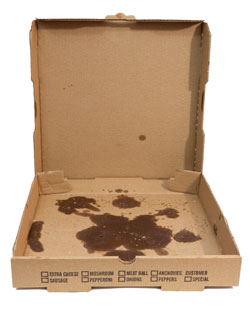The next time you eat carryout pizza, think about why the grease doesn’t seep through the cardboard.
Or when you hear popcorn popping in a bag in your microwave, ask yourself why the paper doesn’t burst into flames.
The answer is PFAS. That’s short for polyfluoroalkyl substances.
They are a group of some 4,700 chemicals that are virtually everywhere.
Besides pizza boxes and microwave popcorn, they are used in carpets and upholstery, fast-food wrappers, dental floss, nonstick cookware, fire-resistant fabrics, electrical insulation, and plastics.
And that’s just the beginning.[1]
Researchers have been sounding the alarm over the health effects of PFAS for years.
They are linked to cancer and immune, thyroid, kidney, and reproductive problems. PFAS are called “forever chemicals” because they break down very slowly. They have a half-life of 92 years in the environment and two to eight years in the human body.
PFAS are so common that it’s virtually impossible to avoid them entirely. Almost all Americans test positive for them. Since they are so damaging to human health, it’s a good idea to minimize your exposure.
A new study shows a simple way to do that.
Researchers at Silent Spring Institute analyzed data on PFAS exposure from the CDC. [2]
More than 10,000 people provided detailed information about their diets. They also provided blood samples.
The study found that people who prepared their own meals at home had much lower PFAS levels.
People who ate more fast food or dined more often in restaurants had higher PFAS levels. The researchers believe that restaurant food contains more PFAS because of contact with plastic containers and packaging that contains the chemicals.
Dr. Kathryn Rodgers was a co-author of the study. “The less contact your food has with food packaging, the lower your exposure to PFAS,” she said.[3] [4]
4 Ways to Cut Your PFAS Exposure
As the study suggests, you should avoid prepackaged and fast foods. As often as possible, make your own meals at home using fresh ingredients.
But there are other ways to minimize your PFAS exposure…
- Don’t use nonstick pans. PFAS are often in Teflon and other nonstick coatings. Use cast iron, stainless steel, glass, ceramic, or stoneware instead.
- Buy the right dental floss. Some brands contain Teflon-like compounds. Teflon is notorious for its PFAS content. Buy wax-coated or non-coated floss.
- Avoid stain-resistant products. Don’t buy carpets, clothing, or furniture that are marketed as stain resistant. Chemicals used for stain resistance contain PFAS. Also avoid finishing treatments such as Stainmaster.
- Be careful with personal care products. Always check the labels of moisturizers, deodorants, cosmetics, hair gels, etc. See if they are made with Teflon or include the words “fluoro,” “polyfluoro,” or “perfluoro.” If so, they have PFAS.
PFAS are everywhere, but that doesn’t mean you can’t reduce your exposure by being a smart consumer.
Editor’s Note: If you’re concerned about exposure to the toxic chemicals that are all around us, you need the Toxin Flush Protocol. It’s a detailed plan to help remove toxins from your system. It was published in Independent Healing, your best source for evidence-based health advice. Go HERE to subscribe.
Related Articles
7 Things You Should Throw Away Immediately
The Dangerous Chemical in Dental Floss
Like this Article? Forward this article here or Share on Facebook.
[1]https://www.pfasfacts.com/?utm_source=google&utm_medium=search&utm_campaign=pfasfacts%20initial&utm_content=0004
[2]https://ehp.niehs.nih.gov/doi/10.1289/EHP4092
[3]https://medicalxpress.com/news/2019-10-people-meals-home-pfas-bodies.html
[4] https://www.medicalnewstoday.com/articles/326598.php

